THE SILK PAVILION : NERI OXMAN ;
DONNA J. HARAWAY : MULTI SPECIES TO EMPOWER ANIMALS
When species meet /Donna Haraway
“Human beings should learn how to share that suffering in non-mimetic ways, namely, not by taking the place of the animal victim but by understanding what the animal is going through in order to get this unequal relationship and power structure right—emotionally, intellectually, ethically, and operationally.”
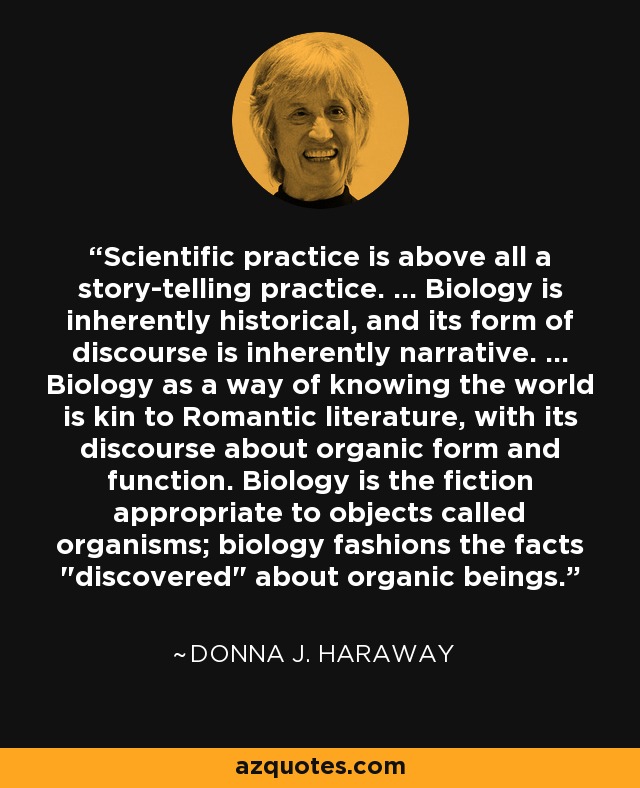
Bookcover “The Companion Species Manifesto: Dogs, People, and Significant Otherness” by Donna J. Haraway
Silk pavilion and the worm’s behavior

Bookcover “When species meet” by Donna J. Haraway
Her main goal is to reflect upon human-animal relationships and other nature cultures to better understand our approaches (the good ones and the bad ones) to technoscience studies. She wishes to examine the history of evolutionary biology as a species, by studying the other species that grow with us as our helpers, workers, threats/enemies and companions/friends. The idea is to look at how these species are linked to us historically on a social, biological and behavioral level.
The process shows painstaking research into the way silkworms interact with their environment; from testing out different 3D spaces under different ambient conditions, to using minuscule motion tracking equipment to examine the cocoon construction process. These findings then informed the construction of pavilion itself – determining both the path of the CNC machine which wove the panels and the density of the thread which served as the foundation for the silkworms themselves.
2.1 Publication
“The Companion Species Manifesto: Dogs, People, and Significant Otherness” by Donna J. Haraway
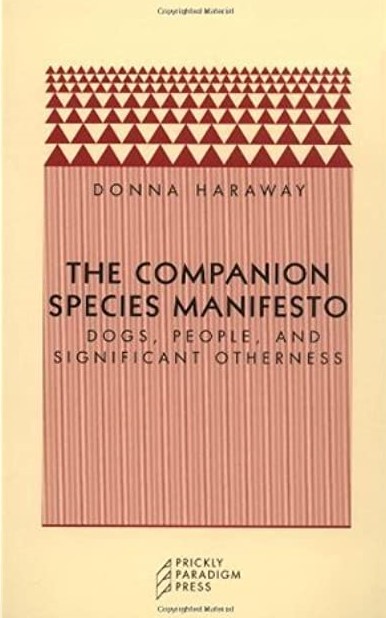
Bookcover “The Companion Species Manifesto: Dogs, People & significant others” by Donna J. Haraway

Painting of herdsmen and cattle, Tassili-n-Ajjer, Algeria. Jean-Dominique Lajoux/ collage
Humans are not a single species, they live in an environment with others, where animals are an inevitable and active part. For Haraway, cross-species companionship involves recognizing the complexity of all beings, discovering each other’s experiences, cultural/species values, abilities, materialities and history. In her work, Donna Haraway focuses on companion species, dogs and people, relationships, who together “figure a universe”.
To better understand how these species are linked to us historically on a social, biological and behavioral level the first section of the book considers “evolution stories”, where the author reviews the process of domestication (in this case wolves-dogs) as purposive and man-driven. Tamed animals made people’s lives easier in terms of herding and guarding resulting in man transforming from “hunter/ tamer to garbage-generator”. This relationship was anthropocentric, but it made civilization possible. Nowadays, living in a contemporary environment where all facilities are available, we can be flexible in our choices and focus more on cooperation with animals instead of controlling them.
The ideal companionship with the companion species according to Donna Haraway comes out of training and work to unleash the true potential of animals. The result of cooperation should be beneficial for both, where species are treated equally, only this way of relationship development could bring productive results.
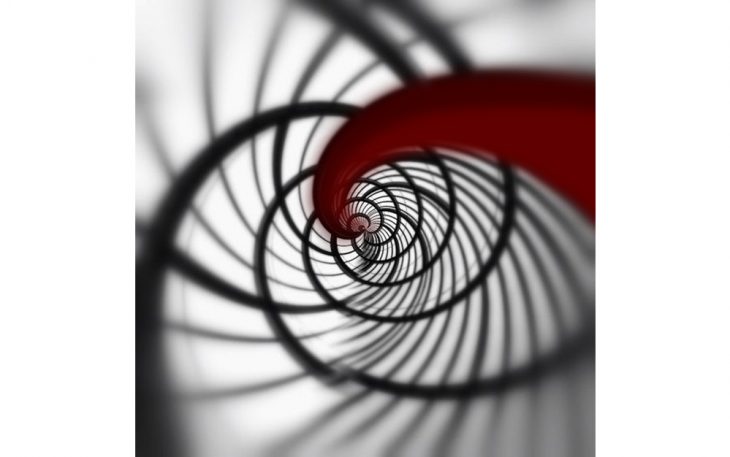
Intertwined branches, Human / companion species
2.2 Socio political event
PETA : People for the Ethical Treatment of Animals
PETA : People for the Ethical Treatment of Animals
As the process of harvesting the silk from the cocoon kills the larvae by boiling them, sericulture has been criticized by animal welfare and rights activists. Since silk cultivation kills silkworms, possibly painfully, People for the Ethical Treatment of Animals (PETA) urges people not to buy silk items.
The silk festival

The silk festival
Every year Institute of Khmer Traditional Textiles hold a Silkworm Festival and Fashion Show at PWF. On the day of the full moon in March, they invite everyone to join in celebration of the silkworms and the lives that sacrificed each year. The whole village makes their livelihoods from what the silkworms provide for them, and they want to say thank for that.
Figure 3-2:SILK PAVILION AND WORM BEHAVIOUR
2.3 Technical device

figure 2.5: A Bombyx mori silkworm positioned within a magneto mete

Figure 2.4: Silkworm with attached magnet for motion tracking.
Technological devices were used while research to understand and predict motion and material deposition behaviour of silk worm.
- The silk worm was attached with three miniature magnets to its head to track its movement.
- The silk worm was then placed in magneto meter motion sensing device which capture worm’s movement in 3D space.
- Wide-angle high resolution MicroCT (microtomography) and SEM (scanning electron microscope) imaging techniques were developed and implemented to analyse the organisational properties of silk textures across various length scales and species.
A subsequent goal was to computationally embody the geometrical complexity and scalability of the Pavilion, as well as the scaffolding resolution and the range of fabrication tools used.
- The structure was designed in Rhinoceros 3D modeler with Grasshopper plugin.
- Grasshopper plugin informed algorithm for scaffolding thread geometry.
- Robotic tools were used for fabrication.
Aluminium frame polygonal profiles were developed using computaional & digital fabrication.The perimeter of the unfolded 2D panels were tied making up the overall structure.

Figure 2.6 :a) Computational silkworm spinning range calculation.
b) Spring steel CNC threading tool and silk thread
c)Three-axis CNC machine adapted as CNC deposition tool. Custom threading tool, temporary aluminum scaffolding and MDF jig.
d) Computational unfolded overall panel layout for fabrication.
2.4 Artist work
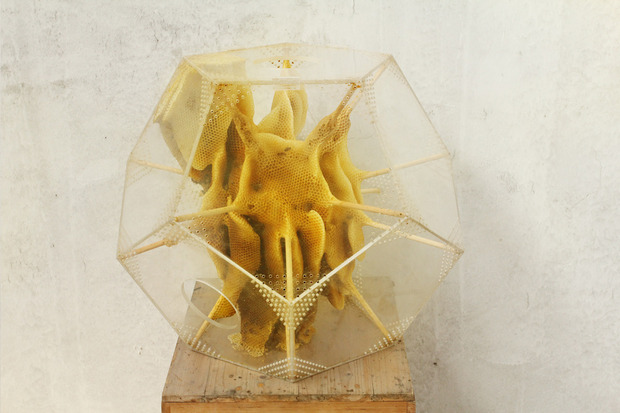
Honeycomb sculpture, Ren Ri, 2014
The sculptures are housed in transparent plastic polyhedrons and the artist Ren Ri employed bees to make it. Ren put a framework of wooden sticks in the middle the polyhedrons. And then the queen bee is kept at the center of the geometric space which results in the other bees gathering around her, to start building around the center. Every week, Ren changes the gravity of the structure by rotating the box onto a different side. By changing the gravity, the bees are building in different directions resulting dispersed forms.
The cooperation
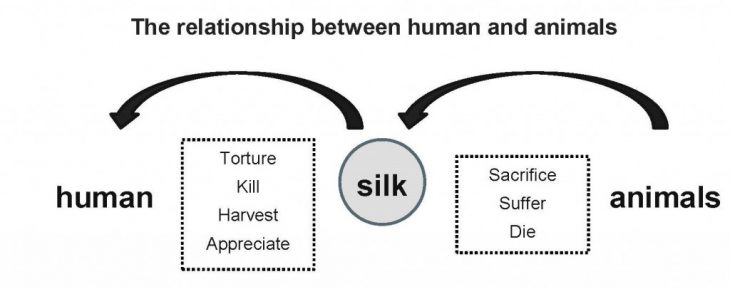
Man-made Structure + Bio-made Cement
Living Breakwaters Project — Oyster Reef
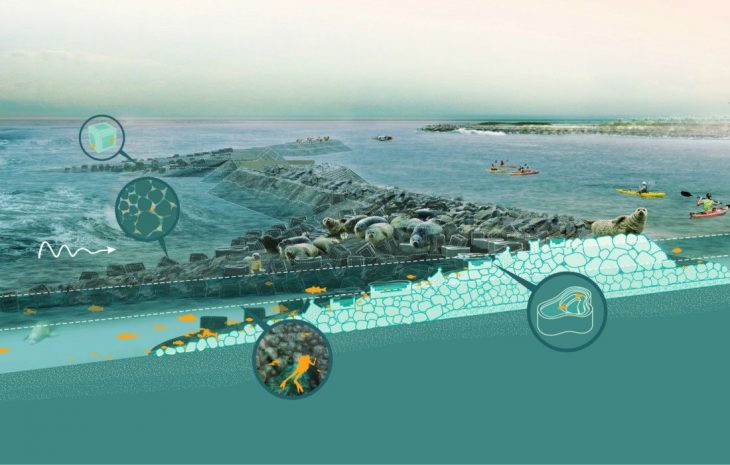
Oyster tecture proposal rendering by Kate Orff, 2009
The silkworms are found to make a “bed” first before wrapping themselves in the cocoon. And the shape of the bed is influenced by the surrounding environment-put it in a corner to make a hammock, or making a flat bed on a flat surface. This is what the environment offers to the animal, what it provides or furnishes, either for good or ill.
Like the silk pavilion, the artist found that beeswax is a very special material; it’s unstable and can change shape with temperature. He places the inner structure as the foundation, and the bees fill all the gaps to result in various shapes of honeycomb. It is the cooperation between humans and nature. By developing and researching more about the behavior, we will certainly see more examples of multi-species assisting humans in creating and crafting in the future.
And this can also be found in the living breakwaters project. Kate Orff’s marine gardening project takes advantage of the oyster’s built-in filtration system. An adult oyster can process up to a massive 50 gallons of water a day, pumping it through their bodies, extracting nutrients and nitrogen pollution. Oyster reef beds could create better habitats for wildlife and even weaken waves to reduce the damage from storm surges.The silk industry has developed for a long time in human history, but nowadays, whether silk should be used is increasingly controversial. People used cruel ways to torture silkworm cocoons to obtain silk, taking their lives, and praising them with gratitude.
Comparison between traditional silk industry and silk pavilion
In the traditional silk industry, silk essentially comes from silkworm spit. Once their cocoons are finished, silk is harvested for human consumption by killing the insect with steam, hot air or boiling. Cocoons are placed in hot water to loosen and extract the silk fibers. It takes about 2,500 silkworms to make one pound of silk , which is of high labor but low tech. And also research have shown that this method will cause silkworms to die in an extremely painful way. While in silk pavilion project, it explores the relationship between digital and biological fabrication on product and architectural scales. They use light to effect the variations in movement of the silkworms, which do not harm to insects.
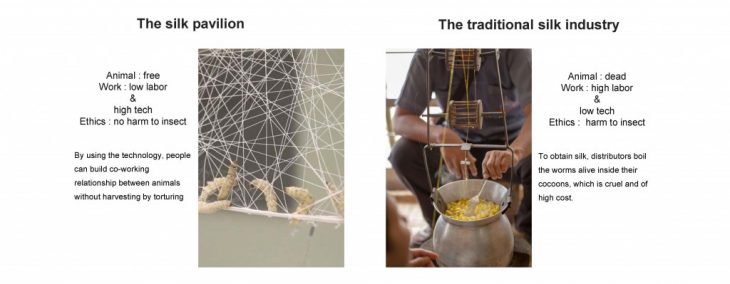
Figure 3-9: Silk Pavilion, Mediated Matter Group, 2013,The Silk IndustrY
Tech Breakthroughs Are Giving Animals the Power to Speak

Dr. Slobodchikoff (animal behaviourist & conservation biologist)
technology is a doble-edged knife, we human beings need to control and make full use of itSimple communication with animals could eliminate guesswork in caring for animals and even save their lives.Scientists and technologists are experimenting with AI-based electronic devices to decode and interpret animal sounds, combining latest technologies, namely:
- electroencephalography (EEG) sensoring, to record electrical activity of the brain.
- The data from EEC is then processed and analysed using micro computers.
- The data from micro computer is retrieved by brain computer interface softwares, that analyze these signals, produce output and provide feedback. Examples of BCI softwares: Bitbrain, NFBLab
Dr. Slobodchikoff (animal behaviourist & conservation biologist) has been able to index the sounds made by prairie dogs, by cross referencing the acoustic qualities of the animals’ cries, with the circumstances in which they were uttered.

The first effective animal translator was Cetacean Hearing & Telemetry (CHAT) translator
The first effective animal translator was Cetacean Hearing & Telemetry (CHAT) translator. Using CHAT scientists could decode dolphin whistles and their meanings.
However, human interaction with dolphins proving to be dangerous to marine life. Increased dolphin familiarity with humans has led to an increase in injury and death to the marine mammals.
Human-centered Design
Penguin Pool by Berthold Lubetkin
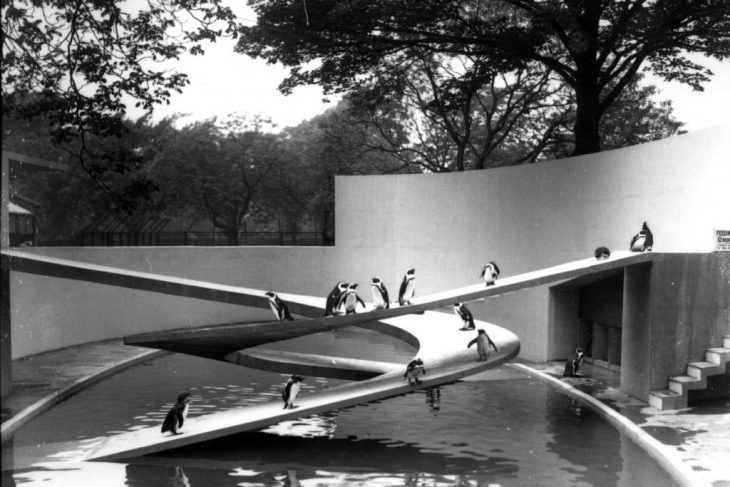
Figure 3.4: The Penguin Pool, Berthold Lubetkin + Tecton Group, 19But there is still a negative reference. While the penguin pool project is regarded as the most influential works of Modern architecture, it has been emptied for 15 years because penguins are sick from walking on the concrete. This architecture is too much emphasis on the satisfaction of human beings towards entertainment and aesthetics, however ignoring the relationship between multi-species and nature.
When human beings are regarded as the center of the universe, it is difficult for us to view the world from other perspectives. In order to reach the symbiosis and prosperity of people and nature, it is necessary for people to take some constraints and think twice about how to use technical devices reasonably.
4. Conclusion
The belief that human beings are the most important entity in the universe has fallen behind, because the synergy between contemporary technology and science has led us far beyond human’s skills and vision. We started using technology in order to expand ways of perception in the fabrication process that our minds are unable to see and analyse.
Silk Pavilion is an example of a close cooperation between companion species, people and animals, which resulted in creating a structure, which reminds us of a dome. Silkworms didn’t follow a predetermined path but they were controlled by the prefabricated metal frame. Thus, we believe that in order to go beyond post-humanistic vision we don’t have to encapsulate animals, we have to free their behavior to unleash their true potential and acknowledge animals as independent beings.
CONCLUSION
Renaissance
![Renaissance, Human-centered philosophy ,To [man] it is granted to have whatever he chooses, to be whatever he wills. -Giovanni Pico della Mirandola (Oration on the Dignity of Man, 1486), EMPOWERING ANIMALS IAAC BLOG , THREE FOLD LOGIC OF ADVANCED ARCHITECTURE , MAA](https://www.iaacblog.com/wp-content/uploads/2020/10/unnamed.jpg)
The Vitruvian Man. Proportions of the Human Body
![Renaissance, Human-centered philosophy ,To [man] it is granted to have whatever he chooses, to be whatever he wills. -Giovanni Pico della Mirandola (Oration on the Dignity of Man, 1486), EMPOWERING ANIMALS IAAC BLOG , THREE FOLD LOGIC OF ADVANCED ARCHITECTURE , MAA](https://www.iaacblog.com/wp-content/uploads/2020/10/c0217816-pico_della_mirandola_italian_philosopher.jpg)
-Giovanni Pico della Mirandola (Oration on the Dignity of Man, 1486)
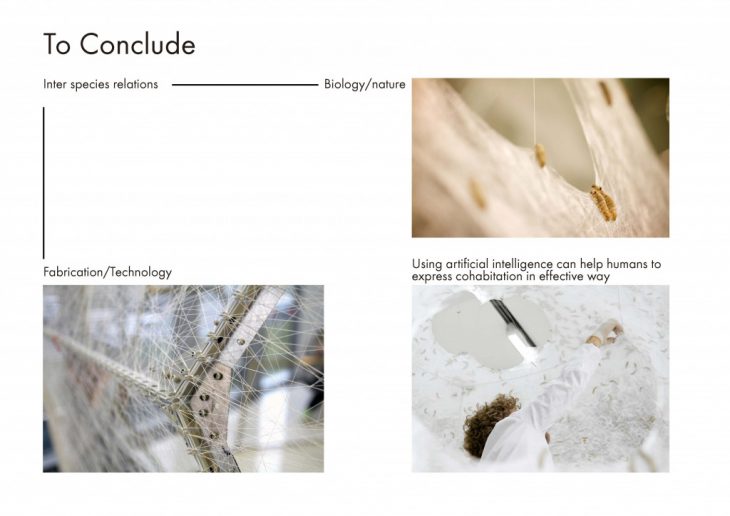
Bibliography
Allen, Stan. “Field Conditions”. In Points + Lines, Edited by Mark Lamster, New York: Princeton Architectural Press, 2012.
Aristotle, On Sophistical Refutations. Translated by W.A. Pickard. Cambridge: The Internet Classic Archive, 1994.
Aristotle. Physis. Translated by W.A. Pickard. Cambridge: The Internet Classics Archive, 1994.
Aureli, Pier Vittorio. “Means to an End”, in The City as a Project. Edited by Pier Vittorio Aureli. London: Ruby Press, 2011.
Baudrillard, Jean. Fatal Strategies. Translated by Phil Beitchman. London: Semiotext, 2008.
Bauman, Zygmunt. Liquid Modernity. London: Polity, 2000.
Benjamin, Walter. The Work of Art in the Age of Mechanical Reproduction. Translated by Claude Kipper. London: CreateSpace Independent Publishing Platform, 2011.
Böck,Ingrid. Six Canonical Projects by Rem Koolhaas. Viena, Jovis, 2012.
Boom, Irma: “Ramp”, in Elements of Architecture, edited by Rem Koolhaas. Rome: Marsilio, 2014.
Bryant, Levi. “The Ontic Principle: Outline of an Object-Oriented Ontology” in The Speculative Turn, edited by Levi Bryant, Nick Srnicek and Graham Harman. Melbourne: re.press, 2011.
Cache, Bernard. Earth Moves: The Furnishing of Territories. Translated by Anne Boyman. London: Writing Architecture, 1995.Carpo, Mario. The Alphaber and the Algorithm. Massachussets: MIT Press, 2001.Berlage, H.P. et al. “CIAM’S La Sarraz Declaration (1928)”, Modernist Architecture, uploaded by Ross Wolfe, last modified September 8, 2001.
Delanda, Manuel. Intensive Science & Virtual Philosophy, London: Bloomsbury, 2013.
Deleuze, Gilles. Difference and Repetition. Translated by Paul Patton. New York: Continuum International Publications, 2004.
Silk Pavilion: Multi-species is a project of IAAC, Institute for Advanced Architecture of Catalonia developed in the Masters in Advanced Architecture (MAA01) 2020/21
By Students: Rana Ibrahim, Victoria Fedorova, Nan Yin, Ziying Zeng, Kajal Unahariya
Faculty: Manuel Gausa and Jordi Vivaldi Piera.